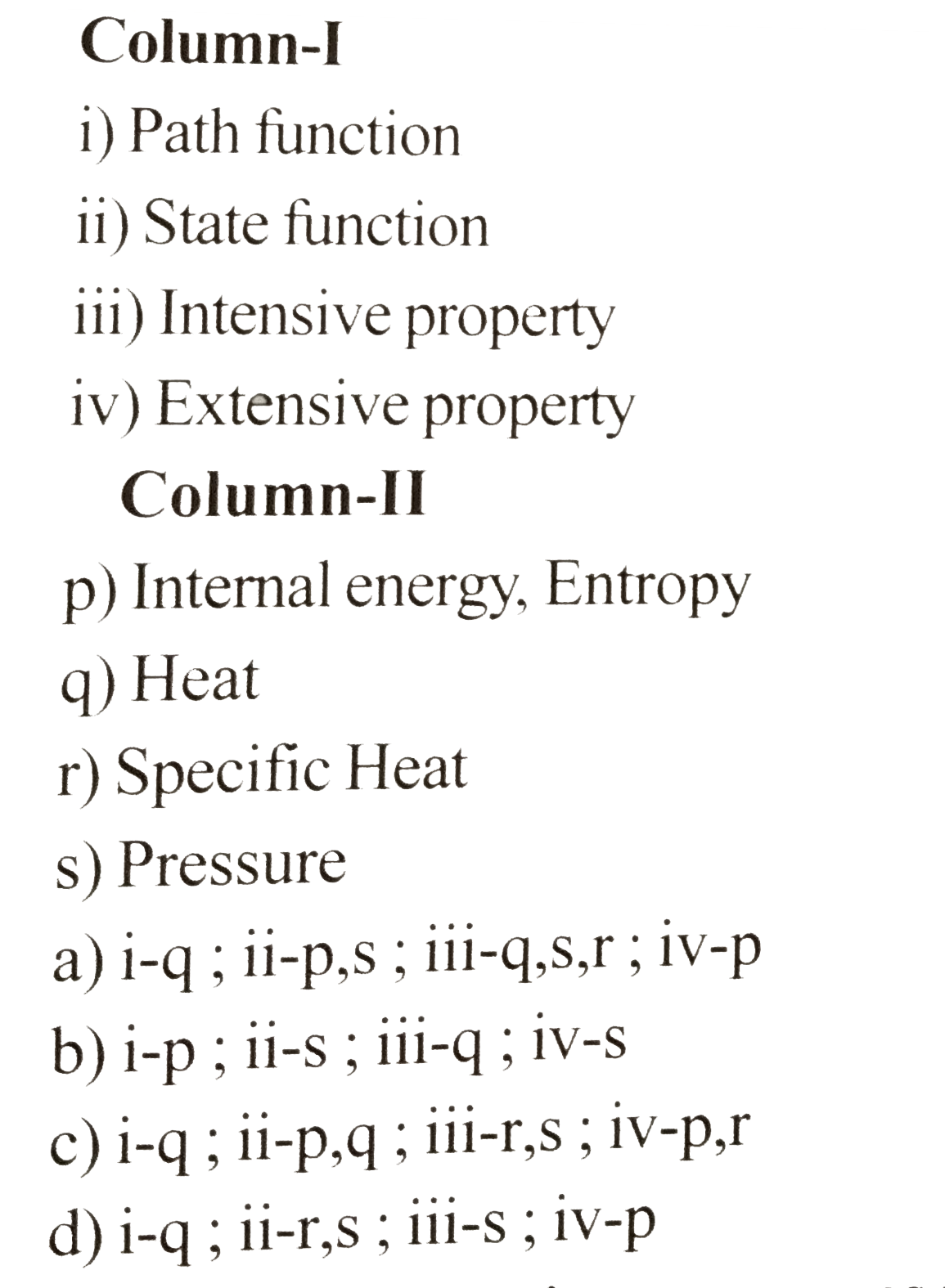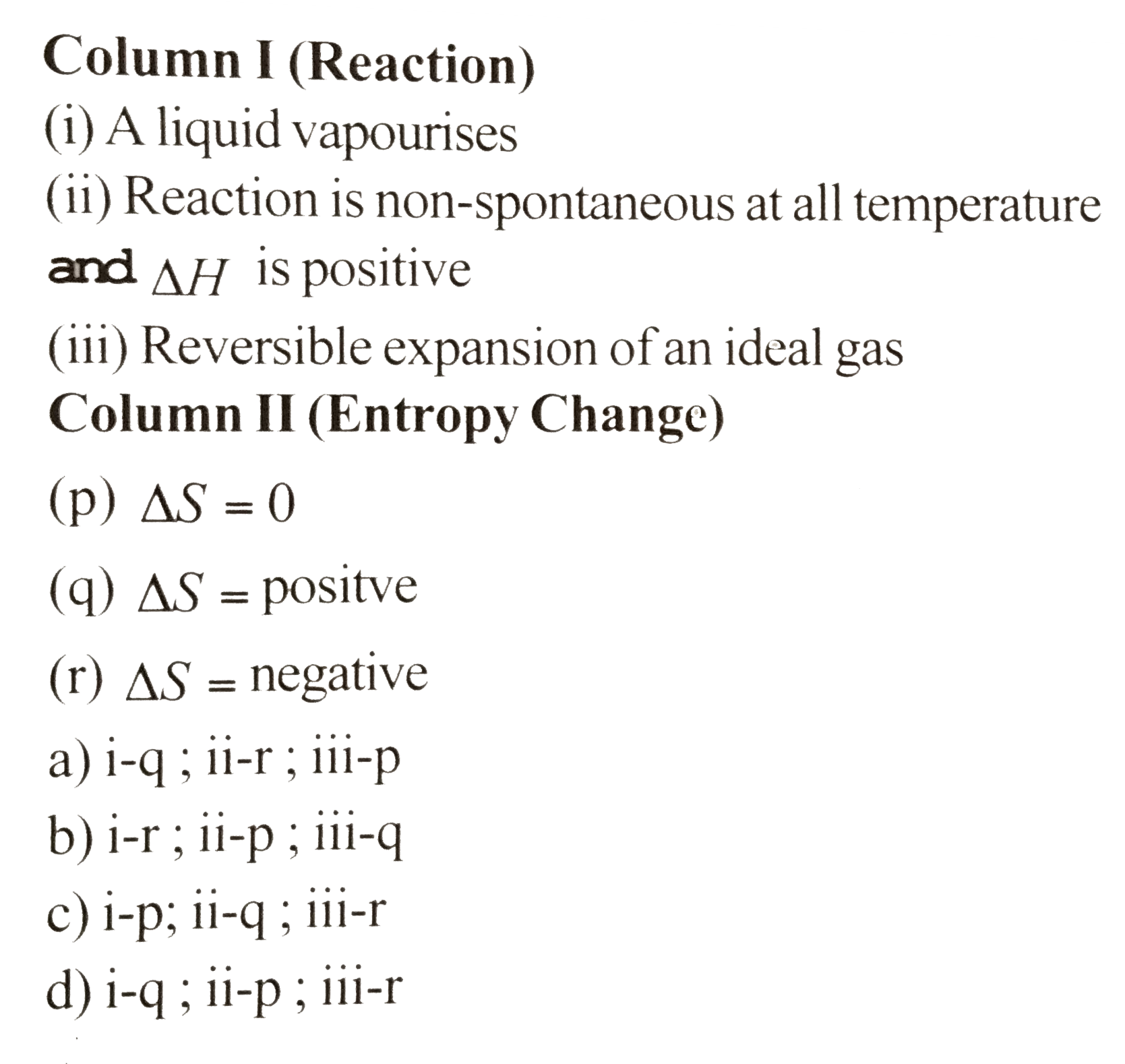Complete Solutions to Level-IV of chapter THERMODYNAMICS of Class 11 book with complete answers and questions
| Class 11 | CHEMISTRY |
| Chapter | THERMODYNAMICS |
| NARAYANA | Level-IV |
| Number Of Questions | 27 |
| Academic Year | 2023-24 |
Thermodynamics is not concerned about….
View SolutionWhich of the following statements is correct?
View SolutionThe state of gas can be described by quoting the relationship between
View SolutionThe volume of gas is reduced to half from its original volume. The specific heat will be
View SolutionDuring complete combustion of one mole of butane ,2658Kj of heat is released. The thermochemical reaction for above change is
View Solution`delta_(f) U^(Ө) "of formation of" CH_(4)(g)` at a certain temperature is `-393Jmol^(-1).` The value of `delta H^(Ө)is:`
View SolutionIn an adibatic process, no transfer of heat takes place between system and surroundings. Choose the correct option for free expansion of an ideal gas under adiabatic conditions from the following :
View SolutionThe pressure volume work for an ideal gas can be calculated by using the expression `w=-int_(V_(i))^(v_(f))Pex dV`. The work can also be calculated from the pV-plot by using the area under the curve within the specified limits. When an ideal gas is compressed (a) reversibly or (B) irreversibly from volume `V_(i)` to `V_(f)` choose the correct option.
View SolutionThe entropy change can be calculated by using the expression `DeltaS-(q_(rev))/(T)`. When water freezes in a glass beaker, choose the correct statement amongst the following:
View SolutionOn the basic of thermochemical equations (I),(II)and (III), Find out which of the algebraic relationships given in options (a)to (d) is correct ?
(I)`C("graphite")+O_(2)(g)to CO_(2)(g),`
`Delta_(r)H=XKJmol^(-1)`
(II)`C("graphite")+(1)/(2)O_(2)(g)toCO(g),`
`Delta_(r)H=yKJ mol^(-1)`
`(III) CO(g)+(1)/(2)O_(2)(g)toCO_(2)(g), Delta_(r)H=zKJ mol^(-1)`
View SolutionConsider the reactions given below .On the basis of these reactions ,Find out which of the algebraic relations given in options (a) to(d) is correct?
`(p)C(g)+4H(g)toCH_(4)(g), Delta_(r)H=xKJ mol^(-1)`
`(Q)C("graphite")+2H_(2)(g)to CH_(4)(g),`
`Delta_(r)H=yKJmol^(-1)`
View SolutionThe enthalpy of elements in their standard atates are taken as zero .The enthalpy of formation of a compound:
View SolutionEnthalpy of sublimation of a substance is equal to :
View SolutionWhich of the following is not correct ?
View SolutionThermodynamics mainly deals with:
View SolutionIn an exothermic reaction heat is evolved and system loses heat to the surrounding. For such system
View SolutionThe spotanity means having the potential to proceed without assistance of external agency. The processess which occur spontaneously are
View SolutionFor an ideal gas, the work of reversible expansion under isothermal condition can be calculated by using expression ` = -nRT ln.(V_(f))/(V_(i))`. A sample containing 1.0 mol of an ideal gas is expanded isothermally and reversible to ten times of its original volume, in two separate experiments. The expansion is carried out at 300 K and at 600 K respectively. Choose the correct option
View SolutionConsider the following reaction between zinc and oxygen and choose the correct options out of the options given below
`2Zn(s)+ O_(2)(g) to 2 ZnO_(s): DeltaH=-693.8 kJ mol^(-1)`
View SolutionMatch the following columns

View SolutionMatch the following columns

View SolutionMatch the following columns

View SolutionMatch the following columns

View SolutionMatch the following columns

View SolutionStatement-1: Combustion of all organic compounds is an exothermic reaction .
Statement-2: The enthalpy of formation of all elements in their standard state are zero.
View SolutionAssertion:Spontaneous process is an irreversible process and may be reversed by some external agency.
Reason:Decrease in enthalpy is a conrtributory factor for spontaneity.
View SolutionStatement-1:A liquid crystallises into a solid and is accompainied by decrease in entropy.
Statement -2: In crystals, moles cules organise in an ordered manner.
View Solution
Level-IV questions and complete solutions for chapter THERMODYNAMICS of NARAYANA CHEMISTRY (HINGLISH) of Class 11